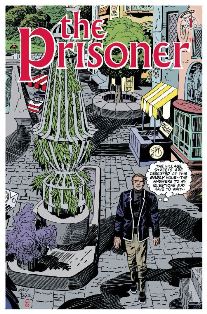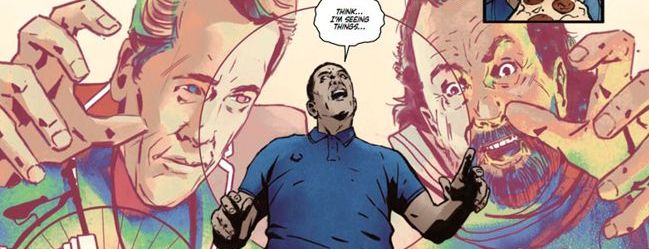 |
The Prisoner
"The Uncertainty Machine" Part 1
The Prisoner: The Uncertainty Machine #1
Titan Comics
Writer: Peter Milligan
Original plot: David Leach
Artist: Colin Lorimer
Colorist: Joana Lafuente
Letterer: Simon Bowland
Cover: Mike Allred
June 2018 |
Agent Breen of MI5 has a plan to free another agent friend from
the Village.
Notes from the Prisoner chronology
The beginning of the issue informs the reader that it is the
21st Century.
Characters appearing or mentioned in this issue
Agent Breen
pursuers
chess man
Agent Carey
Section
Sarif
Duff
Simon Maggs (last name revealed in
"The Uncertainty Machine" Part 2)
Undertaker
Didja Know?
The Titan Comics version of The Prisoner is a comic
book mini-series reimagining of
the classic 1967 TV series of the same name.
The covers of each issue of this mini-series state the series
title only as The Prisoner, but the indicia inside each
issue indicates the actual series title is
The Prisoner: The Uncertainty Machine.
The title of this mini-series,
The Uncertainty Machine, may have
been borrowed from the
NIST
Uncertainty Machine web-based software application developed
by the National
Institute of Standards and Technology.
In this comic book series, Number 6 is an MI5 agent named Breen.
His likeness is nothing like that of the unnamed Number 6 played
by Patrick McGoohan in the
1967 TV series. However, a
number of the variant covers of the series depict McGoohan in
homage to his role.
Each issue of the series had the issue number on the cover
within the wheel of the penny-farthing symbol of the Village,
like the badges most of the Village inhabitants wear to identify
their assigned number.
Each issue credits
The Prisoner as created by
Patrick McGoohan and George Markstein. They created the
classic 1967 TV series.
The slogan presented at the beginning of each issue is
"Information is Power".
|
Variant Cover Three of this issue is artwork by the late
Jack Kirby (1917-1994), borrowed from the art he drew
for the aborted 1977 Marvel Comics adaptation of The
Prisoner.
You can read the first six pages of Kirby's adaptation
(inked and lettered by Mike Royer) at
the Internet Archive page of the Red Circle. |
 |
One of the exclusive covers of this issue is based on the cover
art of The Prisoner audio drama CD Volume 1 released by
Big Finish Productions. The audio series is a remake of the
classic 1967 TV series.
Studies of the excellent audio drama can be found at PopApostle
on the Prisoner - Big
Finish page.
Didja Notice?
The beginning of the issue informs the reader that the Village
is a place where the most valuable information in the world is
mined. The Village is aligned to no one political system or
state, an autonomous institute, free of state manipulation. The
identity of its controller, Number 1, is unknown.
As the story opens, MI5 agent Breen is escaping from a Chelsea
safe house that turned out to not be so safe.
Chelsea is an affluent neighborhood of South West
London.
On page 2, Breen wonders if his pursuers already know about
Pandora.
On page 2, panel 4, Breen is seen to be buckling his belt as he
flees down the street from his pursuers after jumping from the
second story window of the safe house while thinking to himself,
"A good MI5 agent shouldn't be caught with his trousers down."
Since he seems to be otherwise fully-dressed, it seems likely
he was sitting on the toilet when his pursuers busted into the
safe house.
MI5 is the UK's domestic counter-intelligence agency, more
formally known as Military Intelligence, Section 5; later in
this issue, it's revealed Breen worked for a department of MI5
called the Unit. The Unit is fictitious as far as I can tell.
On page 3, Breen is seen walking into
King's Cross railway station.
Also on page 3, Breen mentions the book The Spy Who Came in
from the Cold. This is a 1963 spy novel by British author
John le Carré, set during the Cold War.
Breen sees the headline of the
Evening
Standard on page 3, featuring his photo: "TRAITOR: HIGH
RANKING SPY BETRAYS COUNTRY".
On page 5, as Breen knocks out a man playing chess by himself in
the men's room, he says, "Zugzwang!"
Zugzwang
is a German term meaning "compulsion to move", used in chess
when a player has no choice but to make a move that will only
worsen their position.
In
the last panel of page 5, Breen hops into a cab and asks to be
taken to
City Airport.
On page 6, Breen describes the accent of his new
identity as having a hint of Hibernian. "Hibernian"
is an affectionate term relating to Ireland.
Also on page 6, Breen muses on having turned from
one of his unit's most trusted agents to "the bastard son of a
Philby or Blake". Kim Philby (1912-1988) and George Blake
(1922-2020) were British agents who were actually double agents for
the Soviet Union.
|
Breen travels to Tuscany, where he owns a cottage, on
page 6.
Tuscany is a region of Italy. He muses that he has
occasionally rented the cottage out on
Airbnb.
The exterior depicted is much more than what most people
would consider a cottage! |
 |
 |
On page 7, Breen hallucinates images of chess pieces, a
penny-farthing, and images of Number 6 and Number 2 as portrayed
by
Patrick McGoohan and Leo McKern, respectively, in the 1967 TV series.
Oddly, Number 6 appears to have two different-colored eyes here. |
On page 8, Agent Carey inventories an audio drill, microdot cam,
encoder pods, Hydra-Shok, and two
Beretta
M9s. These are all real objects that could be useful in the spy
field. Most are fairly self-explanatory. Hydra-Shok is a type of
hollow-point bullet.
Page 8 reveals that Breen and Carey had a sexual relationship in
the recent past.
On page 9, Breen mentions ISIS.
ISIS is the Islamic State of Iraq and the Levant, a Salafi
jihadist militant group designated a terrorist organization by
the United Nations.
Also on page 9, Breen muses that the men who pursued him and
Carey carried H&K rifles.
H&K is likely a reference to
Heckler & Koch,
a German weapons manufacturer.
On page 12, the Unit section chief refers to Le Grand K having
been stolen "two years ago". Le Grand K is a nickname given to
the International Prototype of the Kilogram, a platinum alloy
object that was used to define the exact mass of a kilogram
established in 1889 by international accord. It is stored in a
vault in Paris as described here. The theft described here is
fictitious, having apparently been orchestrated by agents of the
Village. In May 2019, a new definition of the kilogram was
established based on physical constants instead.
The Unit section chief also tells Breen that
Einstein's brain was recently stolen from the Mütter Museum in
Philadelphia. The
Mütter Museum has only ever had microscope slides of small
slices of the brain; the rest of the preserved portions of the
brain are in the care of the National Museum of Health and
Medicine in Silver Spring, Maryland.
The image in panel 4 of page 12 of a shelf of human
skulls with a gap on the shelf marked with a small V (for
Village) is seemingly meant to indicate the stolen brain, but
the preserved brain was no longer in Einstein's skull in the
first place! During Einstein's autopsy, the brain was removed
and cut into several sections and preserved in alcohol in jars.
The section chief remarks that in all its "known" history, only
one agent has ever escaped from the Village and that agent went
mad.
On page 15, Breen visits his usual pub in Portobello. There are
a few Portobellos this could refer to. The most well-known one
is probably the Portobello area of Dublin, Ireland.
To get into the isolated government installation in Scotland on
page 17, Breen uses the code 21.04.26, the queen's birthday.
Queen Elizabeth II was born on that day.
The design of the Village and Number 6's cottage as presented here is
essentially the same as that in the
1967 TV series.